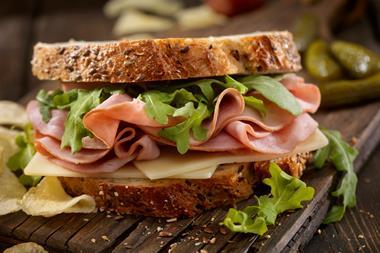It wasn’t long ago that the baking industry was at war with trans fats, spending vast amounts of time and money on new ingredients, reformulating recipes and changing production processes. The campaign was successful, with the so-called ’killer fat’ more or less vanquished from bakery products. But just when bakers might have expected some respite, they are suddenly under pressure to take on another enemy of the arteries: saturated fats.
Heart disease targets
Following its work on salt reduction, the Food Standards Agency (FSA) is on a mission to lower cases of heart disease by reducing the nation’s intake of saturated fat from 13.3% of the food we eat to below 11% by 2010. To this end, a wide-ranging consumer campaign launched earlier this year, and the FSA has been working with the food industry to reduce sat fat levels in food.
However, in the next few months, the FSA is widely expected to up the ante by launching a consultation on setting targets for reducing saturated fat in food components, such as pastry and cream, which are used in biscuits, cakes, pastries and savouries. In other words, the kind of reduction targets we have seen for salt in food are likely to be rolled out to saturated fats.
For the moment, the FSA is keeping tight-lipped about the consultation, although a spokesperson did say: "We have noted the excellent progress already made by some companies that have reduced saturated fat significantly across many lines. We believe our recommendations will galvanise and encourage wider industry engagement and quicken progress."
As reported in BB’s 10 April issue, the baking industry is dead set against the idea of targets for saturated fats. Several baking industry sources have told British Baker they feel such a scheme would be a step too far, especially when the industry is already working hard to cut saturated fats. "It’s another example of the nanny state. We’re already addressing the issue and don’t need government interference," is how one irate baker put it.
Mark Muncey, marketing manager at pasty and bis- cuit company Proper Cornish, echoed this view. "Targets are not the way to go. A pasty is an authentic product and if you take out too much fat, you lose that authenticity. There needs to be a balanced view - more education about diets rather than targeting particular groups of products."
Technical difficulties
According to Barbara Gallani, Biscuit, Cake, Chocolate and Confectionery sector manager at the Food and Drink Federation, cutting saturated fat is technically more difficult - and hence more expensive - than reducing salt, especially if the FSA goes down the route of setting targets for individual components of a product, rather than the pro- duct itself.
"Reductions couldn’t be made in chocolate, because of strict legal definitions of what chocolate must contain, while there is very little that can be done with cream," she said. "There are also issues with composite products. If you use dough with reduced saturated fat in a chocolate-covered biscuit with a cream filling, there would be problems with fat migration and shelf-life."
The costs involved in reformulating products are highlighted by United Biscuits’ recent work to halve saturated fats in its McVitie’s biscuits. The project took three years and a whopping £6.5m of investment to complete.
At bakery consultancy Bake-Tran, director Stan Cauvain said there are also technical hurdles to cutting saturated fats in meat-based bakery products. "Manu- facturers know that targets are coming over the horizon and they are already working to cut saturated fat, but there is a limit. If you look at trying to reduce fat in a pork pie, it’s difficult. Generally, cheaper cuts of meat are used and fat is marbled throughout, which means you cannot trim it away. You could use a different cut of meat, but then that would push up the price. Then there is the pastry. There are things you can do to reduce saturated fats, but in reality, a good crisp pork pie crust needs a high melting point fat (usually an animal fat), which is a key characteristic of saturated fat."
As Stephen Bickmore of Vandemoortele explained, fats suppliers have been working hard to reduce saturated fats by using palm oil and palm fractions, as well as a process called interestification. "These changes do not all come cheaper and, to maintain quality, there needs to be an acceptance that there could be a cost associated," he warns.
Gary Atkinson, operations director at AAK, a leading supplier of fats to the baking industry, said that emulsifiers and enzymes can also be used to improve functionality in low-saturated fat shortening, although this kind of technology clashes with the trend for clean-label.
Predicting what kind of reduction targets the FSA will set for bakery products is not easy, but the overall target of reducing saturated fat in our diets from 13.3% to 11% equates to around a 20% decrease. "That kind of reduction would have to be taken in stages, so that people’s palates could adjust to the changes in the products," said Atkinson. "I would expect a 10% cut in the first year, which could be achieved reasonably easily, followed by further cuts, which could be more difficult depending on how much fat is in a product in the first place."
----
=== Sat fat action ===
Manufacturers are already working to reduce saturated fats in bakery products, as evidenced by a sat fat achievement table for own-label products, published by The British Retail Consortium last month.
l Asda Standard sausage rolls
The retailer completed a project in January that saw saturated fat reduced by 18% across its sausage roll range. This was achieved by changing the cuts of meat used and lowering the fat level in the pastry.
l Asda chilled pizzas
Saturated fat levels were reduced on average by 32% across a range of 14 pizzas last year by looking at the type and amount of cheese, pepperoni and oil used.
l Co-op chilled cheesecakes
A 12% reduction in saturated fat has been achieved since 2007 by changing the proportions of base, cream and soft cheese.
l M&S sandwiches
The retailer worked with suppliers last year to achieve a 30% reduction in saturated fats. One of the ways it did this was by reformulating mayonnaise to include healthier monounsaturated oils.
l Tesco cakes
Tesco says that 110 tonnes of saturated fat were removed from its cakes last year by reducing the use of margarines with high levels of saturated fat.



































No comments yet